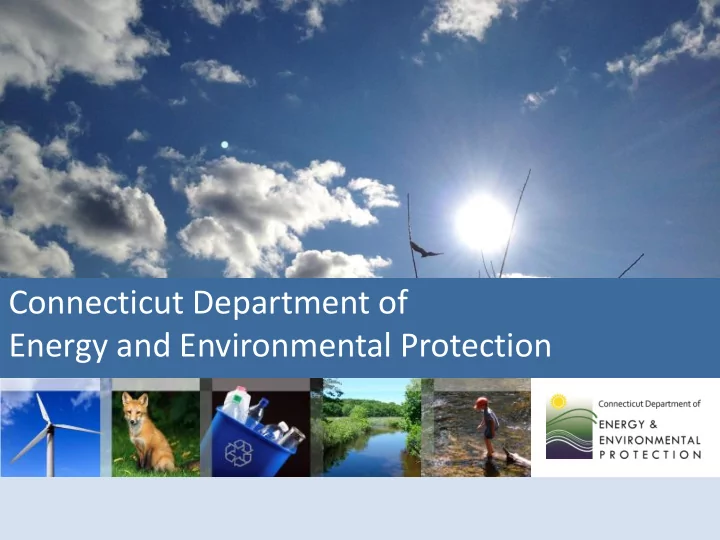

Connecticut Department of Energy and Environmental Protection
Best Management Practices for Forestry : Protecting Water Quality March 16, 2018 SWCS - Southern New England Chapter Sturbridge, MA Connecticut Department of Energy and Environmental Protection
What BMPs are not! • Not the same as regulations • Not a substitute for knowing laws • Not a cookbook or complete installation manual for all techniques • BMP “toolbox” - it’s not enough to describe individual tools and what they do • Instead, describe an adaptable approach to operations planning to maintain water quality Connecticut Department of Energy and Environmental Protection Connecticut Department of Energy and Environmental Protection
BMP Approach • Principles to address WQ outcomes allow a flexible, non-prescriptive approach • Understanding of background and principles helps users recognize where, when, what type of specific BMPs would be most effective Connecticut Department of Energy and Environmental Protection Connecticut Department of Energy and Environmental Protection
BMP Principles - “Fundamental BMPs ” 1. Define objectives and responsibilities 2. Pre-harvest planning 3. Anticipate site conditions 4. Control water flow 5. Minimize and stabilize exposed soil 6. Protect integrity of water bodies 7. Handle hazardous materials safely Connecticut Department of Energy and Environmental Protection Connecticut Department of Energy and Environmental Protection
1. Define objectives and responsibilities • Determine the harvest objectives with the landowner, forester, and logger • Decide who is responsible for BMPs • Find out what legal requirements apply to waterbodies in the harvest area Connecticut Department of Energy and Environmental Protection Connecticut Department of Energy and Environmental Protection
2. Pre-harvest planning • Determine the harvest area limits and property boundaries on the ground • Identify waterbodies: streams, wetlands, ephemeral flows • Identify the areas where you need BMPs (identify material sources) • Layout harvest on the ground • Choose BMPs that are appropriate to the site conditions • Decide on BMPs for the entire harvest site area and for the closeout before beginning work • Consider the needs of future operations on the same property…different BMPs will apply Connecticut Department of Energy and Environmental Protection Connecticut Department of Energy and Environmental Protection
3. Anticipate site conditions • Time operations appropriately • Determine whether previous operations in the harvest area created conditions that are impacting – or could impact – water quality • Plan to monitor, maintain and adjust BMPs as needed Connecticut Department of Energy and Environmental Protection Connecticut Department of Energy and Environmental Protection
• Click to Add Connecticut Department of Energy and Environmental Protection
4. Control water flow • Understand how water flows in and around harvest area • Slow down runoff and spread it out • Protect the natural movement of water through wetlands Connecticut Department of Energy and Environmental Protection Connecticut Department of Energy and Environmental Protection
5. Minimize and stabilize exposed soil • Minimize disturbance of the forest floor, especially in filter area • Stabilize areas of exposed soil within filter areas and in other locations where runoff has the potential to reach filter areas Connecticut Department of Energy and Environmental Protection Connecticut Department of Energy and Environmental Protection
6. Protect integrity of waterbodies • Protect Stream channels and banks – Avoid blockage • Fish Passage • Leave enough shoreline vegetation to maintain water quality – Shade Maintaining existing chemical, physical, biological integrity of surface waters. Connecticut Department of Energy and Environmental Protection Connecticut Department of Energy and Environmental Protection
Fish Passage • Minimize – Velocity barriers – Low flow barriers – Jump barriers – Exhaustion barriers – Debris barriers – Behavioral barriers Connecticut Department of Energy and Environmental Protection
7. Handle hazardous materials safely • Be prepared for any emergency – Spill response kit on site – Contact information for fuel, oil, or chemical spills • Use and store hazardous material properly Connecticut Department of Energy and Environmental Protection Connecticut Department of Energy and Environmental Protection
KEY ISSUES • Filter Areas • Stabilization Connecticut Department of Energy and Environmental Protection Connecticut Department of Energy and Environmental Protection
“Filter Areas” • Adjacent to water bodies – Minimum width defined based on slope • 3-dimensional (channel, banks, forest floor, vegetation) • Apply BMPs within FA – protect channel, banks, and forest floor, disperse concentrated flows of water, stabilize soil, maintain vegetation • Modify filter area width as needed: – Ephemeral flow areas, adjacent wetlands, floodplains, stand conditions, concentrated flows Connecticut Department of Energy and Environmental Protection
Filter Areas Connecticut Department of Energy and Environmental Protection
Stabilization • Temporary – Hay or straw mulch, brush slash, tops – Seeding – Temporary erosion control blankets • Permanent – Wood chips, waste wood, bark mulch – Screen gravel – Riprap, gravel – Permanent vegetation
Connecticut Department of Energy and Environmental Protection
BMP Principles - “Fundamental BMPs ” 1. Define objectives and responsibilities 2. Pre-harvest planning 3. Anticipate site conditions 4. Control water flow 5. Minimize and stabilize exposed soil 6. Protect integrity of water bodies 7. Handle hazardous materials safely Connecticut Department of Energy and Environmental Protection Connecticut Department of Energy and Environmental Protection
BMPs for Every Stage “Any single practice or combination of practices that effectively achieves one of these key goals (fundamental BMPs) could be considered an appropriate BMP.” Connecticut Department of Energy and Environmental Protection Connecticut Department of Energy and Environmental Protection
Summary – Plan Ahead – Build it Right – Maintain it – Close it out correctly Connecticut Department of Energy and Environmental Protection
Questions? Chris Martin (860) 424-3630 deep.forestry@ct.gov Connecticut Department of Energy and Environmental Protection
Recommend
More recommend